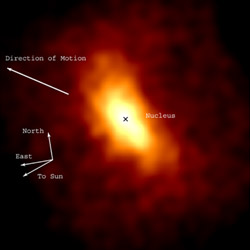July 27, 2000
CXC PR: 00-20

Press Image and Caption
NASA/CXC/C.Lisse, S.Wolk, et al.
Note: Chandra's image of Comet LINEAR has been updated to incorporate new data that brings out the faint extended emission around the comet, correctly label the position of the nucleus, and remove certain processing artifacts. The original image, released in July 2000, can be found in the More Images section. [24 Jan 03]
On July 14, 2000 NASA's Chandra X-ray Observatory imaged Comet C/1999 S4 (LINEAR) and detected X-rays from oxygen and nitrogen ions. The details of the X-ray emission, as recorded on Chandra's Advanced CCD Imaging Spectrometer, show that they are produced by collisions of ions racing away from the Sun with gas in the comet.
"This observation solves one mystery. It proves how comets produce X-rays," said Dr. Carey Lisse of the Space Telescope Science Institute (STScI) leader of a team of scientists from STScI, NASA's Goddard Space Flight Center, Max Planck Institute in Germany, Johns Hopkins University, the University of California, Berkeley, and the Harvard-Smithsonian Center for Astrophysics. "With an instrument like Chandra, we can now study the chemistry of the solar wind, and observe the X-ray glow from the atmospheres of comets as well as planets such as Venus. It may even be possible to observe other, nearby solar systems."
Comets, which resemble "dirty snow balls" a few miles in diameter, were thought to be too cold for such energetic emission, so the detection of X-rays by the ROSAT observatory from comet Hyakutake in 1996 was a surprise. Several explanations were suggested, but the source of cometary X-ray emission remained a puzzle until the Chandra observation of Comet C/1999 S4 (LINEAR). Chandra's imaging spectrometer revealed a strong X-ray signal from oxygen and nitrogen ions, clinching the case for the production of X-rays due to the exchange of electrons in collisions between nitrogen and oxygen ions in the solar wind and electrically neutral elements (predominantly hydrogen) in the comets atmosphere.
The Chandra observation was taken with the Advanced CCD Imaging Spectrometer (ACIS) on July 14, 2000 for a total of 2 ½ hours. The comet will be re-observed with Chandra during the weeks of July 29 - Aug 13. Comet C/1999 S4 (LINEAR) was discovered in September 1999 by the Lincoln Near Earth Asteroid Research (LINEAR) project, which is operated by the Massachusetts Institute of Technology's Lincoln Laboratory to search for Earth-approaching objects.
In addition to Dr. Lisse, the science team involved with the Chandra observations includes: Drs. Damian Christian (CSC/STScI), Konrad Dennerl (MPE), Frank Marshall, Robert Petre, and Steven Snowden (NASA/GSFC), Harold Weaver (JHU), Brett Stroozas (CEA), and Scott Wolk (CfA) )
The ACIS instrument was built for NASA by the Massachusetts Institute of Technology, Cambridge, and Pennsylvania State University, University Park. NASA's Marshall Space Flight Center in Huntsville, Ala., manages the Chandra program. TRW, Inc., Redondo Beach, Calif., is the prime contractor for the spacecraft. The Smithsonian's Chandra X-ray Center controls science and flight operations from Cambridge, Mass.
To follow Chandra's progress, visit the Chandra site at:
MEDIA CONTACTS
Steve Roy
Marshall Space Flight Center, Huntsville, AL
Phone: 256-544-6535
Dr. Wallace Tucker
Chandra X-ray Observatory Center, CfA, Cambridge, MA
Phone: 617-496-7998


